- MOROCCAN TILES -
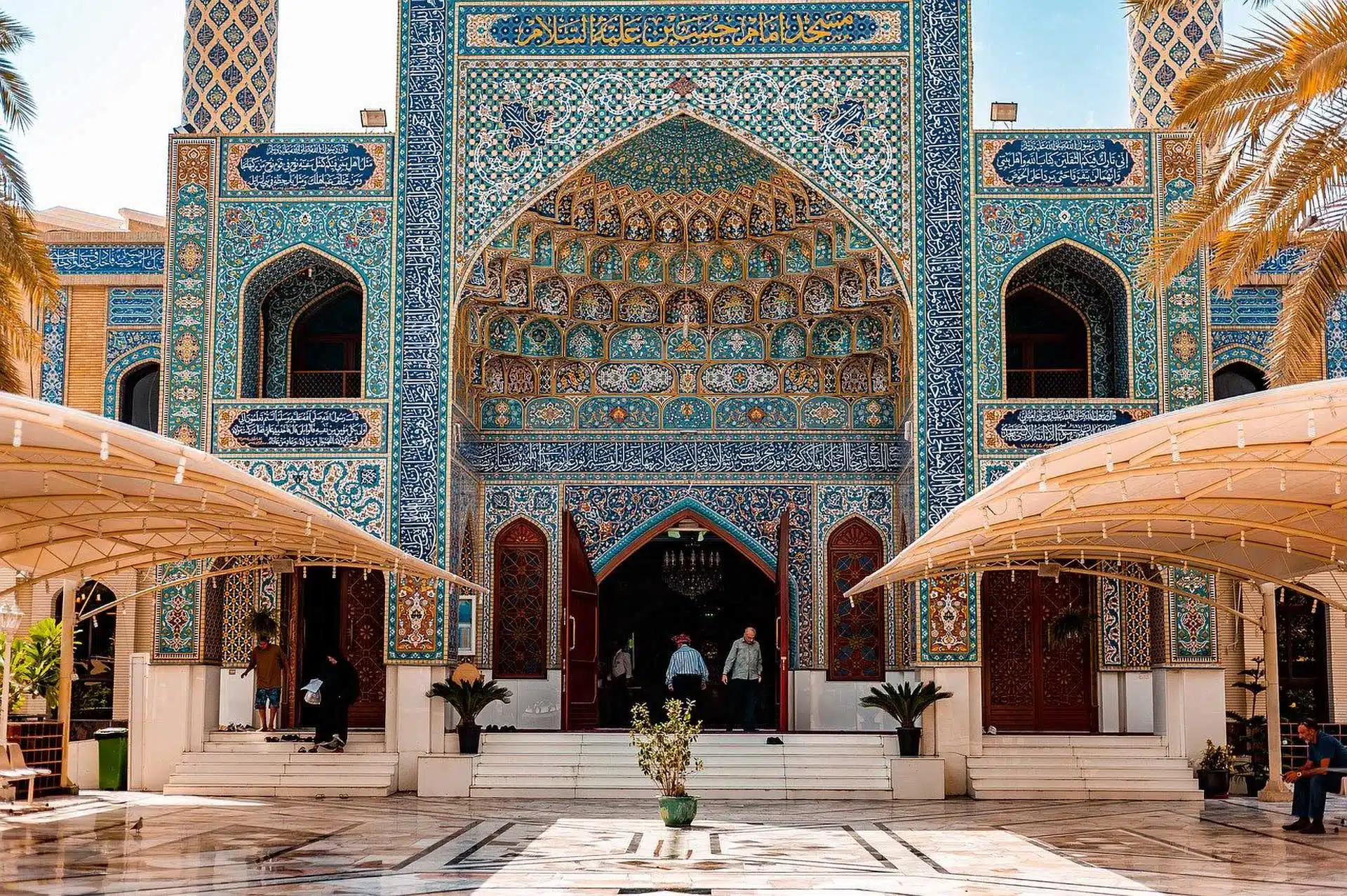
WHAT’S THE DEAL WITH MOROCCAN TILES?
Moroccan tiles design as the years pass, so do trends. Whether in the context of fashion, beauty or cars the majority of people strive to be trendy and stylish. On the one hand we try to distinguish ourselves from others but on the other hand, we long to impress others with our tastes.
When it comes to interior design, it is no different to the trends in fashion or beauty. As years go by and demand for modern housing rises, we are becoming more expectant of beautiful interior decor from the get-go. For one decade, it was cool to have large images on your bathroom tiles, especially ones of aquariums or oceans. At another time, it was popular to show off your house number on a vintage style hand painted tile. Things came and went with interior design, but one style has stood the test of time, and that is Moroccan tiles.

Being in this business for as long as we have, we have never had a decline in the interest in Moroccan tiles. Somewhat of a timeless piece, it is now affordable widely popular in all corners of the world. Even luxury hotels, resorts and spas will opt for Moroccan tiles since they never fail to impress. Unfortunately, these beautiful and classic tiles often get overlooked in their rich and fascinating history. Handcrafted for centuries, their historical and political significance may not have left much of a print on us now, but it has in the past.
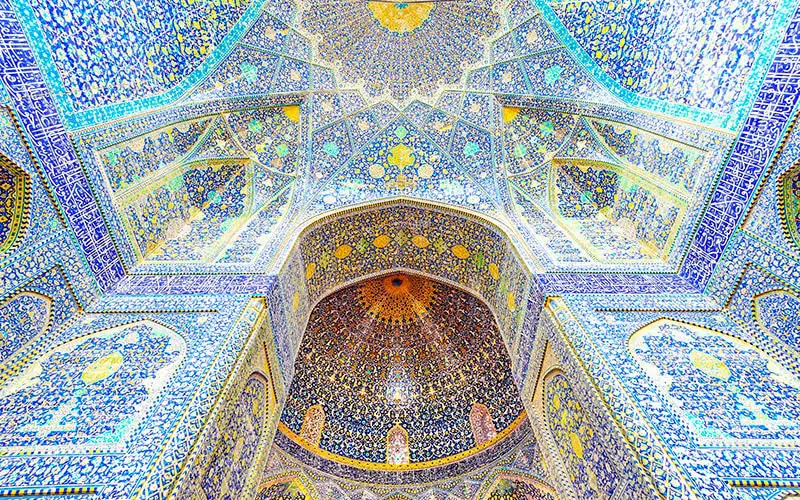
It all started in 711 A.D. when the Moors conquered Spain and introduced their culture to the new found land. In that culture was the practice of painting ceramic tiles in a unique style called Zellige. Zellige was a style consisting heavily of complex geometric styles. The refreshing and new geometric patterns hooked the Europeans on their style and quickly enough the Islamic tradition has placed itself firmly into the homes of many Roman Catholics.
ISLAMIC TILES AND MUSLIM TRADITIONS
Moroccan ceramic tiles have their origins in the Islamic religion and Muslim traditions. The complexity of these patterns is believed to have stemmed from the strict Muslim laws that artists had to follow. Since in the Islam religion they were forbidden to paint living figures, they painted shapes and line work instead. When Zellige first arrived in Europe, it was the most exclusive artistic style available painted only by a handful of artists for aristocrats and royalty. Having your home adorned with Moroccan tiles was a sign of wealth and power and a way to distinguish yourself from lower classes in society. Today, Morocco and many of its households are still heavily adorned in traditional Moroccan tiles and the Zellige design, making the cities of Fez and Meknes the centres of this intricate art form.
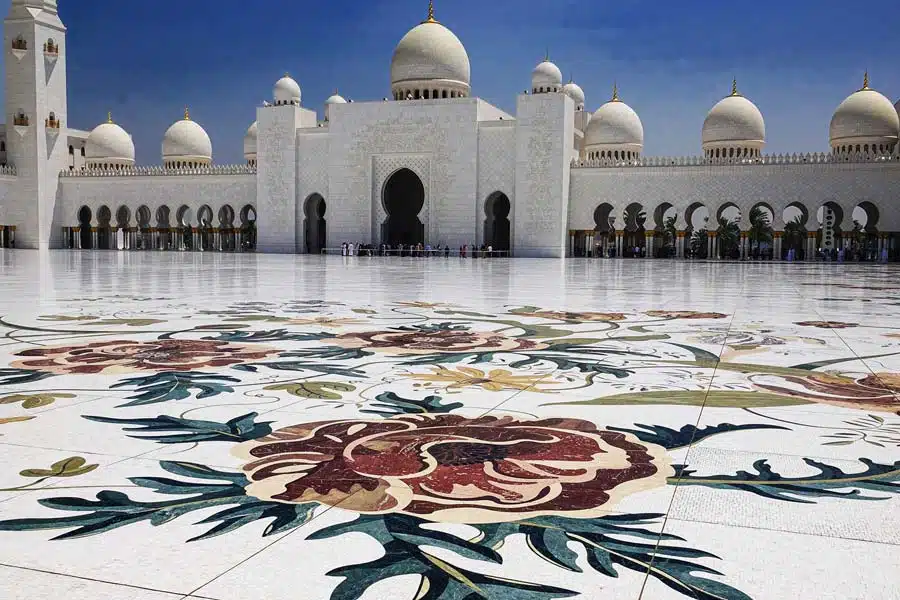
Fez is still the production centre for Islamic tiles because of the Miocene grey clay of Fez. The clay in that region is mainly made of kaolinite. It’s not only durable but easy to work with, and there’s never a shortage.
Interestingly enough, for many people, Islamic tiles are still a show of sophistication. Unlike other styles of ceramic tiles, Islamic tiles stay mostly completely hand painted and have strayed from modern technology such as tile printing. The price point between a complete set of hand painted Islamic tiles, and printed ones are quite huge, but with the technology we possess now there is hardly a difference.
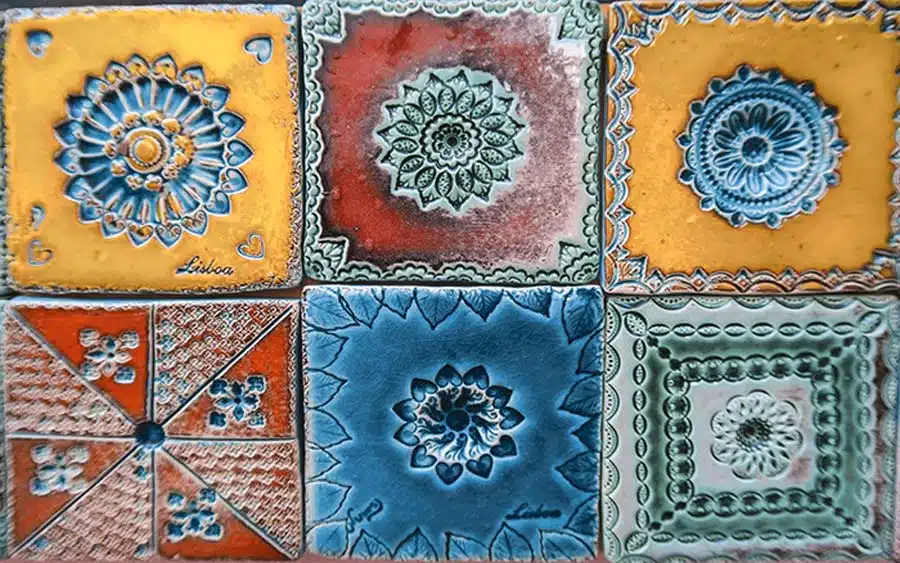
In Morocco, Islamic tiles aren’t just an interior design hit. They’re used heavily in public areas too such as parks or the outside of buildings. Some Moroccan streets and alleys are completely covered in Moroccan tiles, giving the streets that distinguishable blue and white look.
It’s worth noting that Moroccan tiles in Islamic culture were not limited to adorning walls and ceilings. Many people used them to decorate fountains, pools and various pieces of furniture. Unfortunately, the trend of ceramic Islamic tile furniture has declined simply for it’s heavyweight and difficulty moving around.
Islamic tiles, especially the Zellige style usually come in 3d tiles. Over the years however as tastes and technology changed, it also became popular to have Islamic tiles as octagons, creating walls of honeycomb-shaped patterns.
For artists painting Islamic tiles, geometry is the key to achieving the perfect tile. Some designs are made in a way that they strictly work for square tiles, whilst others may only work well on a honeycomb design. The main idea of Islamic tiles is to have each tile perfectly aligned with the next with not a single line or shape unequal to the rest.
The complexity and simplicity of Islamic tiles differ greatly from one design to the next.
One the one extreme, some designs will be really simple and bold. For example four black lines in the shape of a diamond inside a square tile. These kinds of designs are most popular for floors or ceilings. Also common in the bathroom and as kitchen splashbacks.
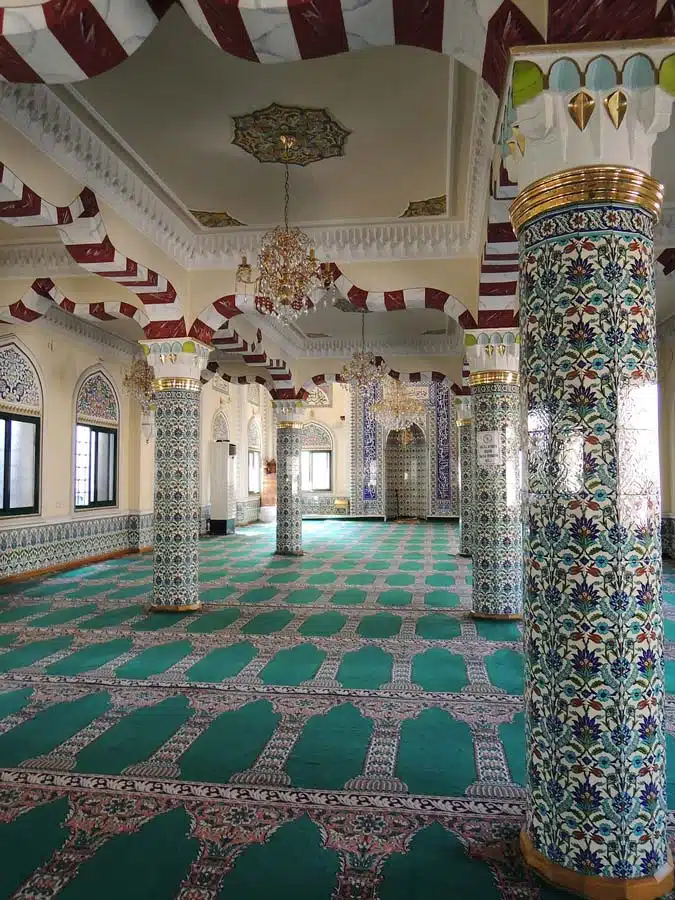
In Morocco, Islamic tiles aren’t just an interior design hit. They’re used heavily in public areas too such as parks or the outside of buildings. Some Moroccan streets and alleys are completely covered in Moroccan tiles, giving the streets that distinguishable blue and white look.
It’s worth noting that Moroccan tiles in Islamic culture were not limited to adorning walls and ceilings. Many people used them to decorate fountains, pools and various pieces of furniture. Unfortunately, the trend of ceramic Islamic tile furniture has declined simply for it’s heavyweight and difficulty moving around.
Islamic tiles, especially the Zellige style usually come in square tiles. Over the years however as tastes and technology changed, it also became popular to have Islamic tiles as octagons, creating walls of honeycomb-shaped patterns.
Moroccan tiles can be quite mesmerising. Imagine a large circular geometric pattern at the bottom of a pool or across a kitchen floor. It attracts all the good attention and it’s difficult to take our eyes off all the little details and colours. One of the main reasons Arabic countries first actually started using Moroccan tiles was because of cleanliness and the same reason can be applied to homes now. Moroccan tiles are also made of the material where bacteria can’t grow and stick to it. This makes keeping a kitchen or bathroom sanitary a lot easier.
Islamic tiles are also good for keeping the interior of your home cool during the summer as they don’t absorb heat yet they also look good and stylish. We’re all guilty of complaining that our homes are either too hot or too cold but thankfully Moroccan tiles don’t keep either cool or warm temperatures, helping places such as a steamy bathroom cool off quicker and avoid moisture and damp building up.
MOROCCAN TILES UK COMPLEX DESIGN
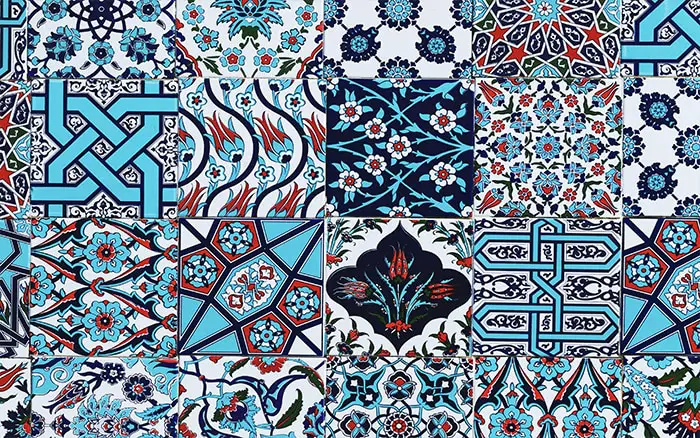
More complex design, usually quite floral and colourful will have the tiniest detail in them and are less likely to be seen in someone’s home. Even in the West, complex Moroccan tile designs can be found on public fountains and furniture. They’re also very popular in luxury hotels and spas, especially as the bottom of pools or walls. These mesmerising designs are usually more expensive and time consuming to make.
Over the centuries, Europe has injected it’s own culture of art and heritage into the traditional Islamic Moroccan tiles. While it has kept within the typical geometric and colourful designs, it has added it’s own twist. Now you can find Moroccan tiles featuring European flowers and symbols. Not only that, different races across Europe have used their traditional folk styles as an influence to add on top of Moroccan styles. This has created a wide variety of interior designs that can be traced back to many different countries around Europe, but all are influenced by the old Zellige style.
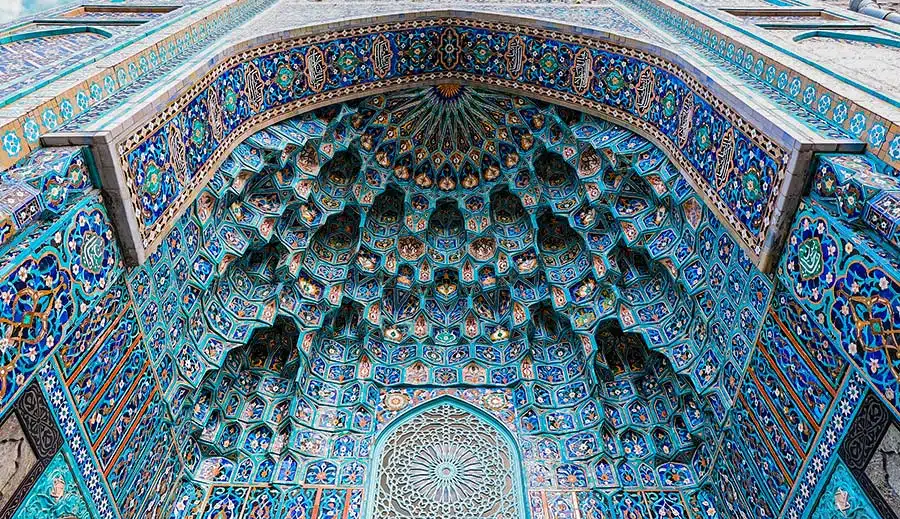
So how do you bring the summer holiday feel of Islamic Coulture into your home and make it look good?
When Moroccan tiles aren’t done with a lot of thought put into it, they can look overwhelming or just ‘wrong’ in your household. So here’s a few tips and ways to bring Moroccan tiles into your home and make them look really good.
The first and most important thing you have to think about is the cost. A single Moroccan tile can cost you anywhere from £1 to over £90! This all depends on how the tile was made, for example, if it’s a digital transfer it will usually be cheaper than hand painted.
So now that you know your budget, you can get down to the fun bit.
A lot of the time Moroccan tiles are very intricate and colourful, so large pieces such as having your entire kitchen done can be overwhelming and difficult to look at. Instead, if you’re doing up the kitchen let’s say, settle on laying a few tiles as a kitchen splashback. This especially applies to you if your home design is quite minimalistic and relies on light colours like vanillas and whites. Moroccan tiles look best when they have a clear beginning and end to their design. For example instead of carrying on a pattern across the kitchen then abruptly ending it as the wall ends, have the last two tiles on each side have a clear ending to the pattern. This can help to produce a cosy feeling in large kitchens.
If the cost of Moroccan tiles or the look of an entire geometric image doesn’t take your fancy, there’s a great way of mixing things up. Especially on fireplaces or in showers, try alternating Moroccan tiles with plain white ceramic tiles. The only thing to watch out for with this idea is to make sure that each Moroccan tile is a complete geometric design in itself rather than part of something bigger. Remember what we said about the complete design!

If your home already has a traditional Mediterranean look to it, Moroccan tiles like that can just up the game a little bit and add enthusiasm to your space. To make blue and white Moroccan tiles work, keep the rest of your space quite low-key. Try keeping painted walls white and accessorise with a clear colour scheme in mind. Blue on white designs of Moroccan tiles are extremely intricate so trying to incorporate that style into the rest of your space can be overwhelming.
On the other hand, there’s the choice of Moroccan tiles with European twists. These are usually quite warm coloured tiles depicting geometric shapes, patterns and floral designs. These types of Moroccan tiles are mostly used in countryside cottages as a way of bringing in the beautiful wildlife outside, indoors. These type of Moroccan tiles also look beautiful when encased in wooden frames. For example, if you live in quite a historic home with a beautiful wooden staircase, Moroccan tiles can look beautiful on the main bannisters, encased in polished oak.
Yet, colourful and European influences on Moroccan tiles don’t always have to be confined to old cottages. If done right, they can look just as great in a modern household. Like we mentioned before, many of them will be warm coloured, so think along the lines of your reds, yellows and oranges. The key to this is dropping the floral design and going for bolder shapes that create a larger geometric design. Similar to what you would see at a resort, designs like that work beautifully on a large kitchen floor or as part of your garden patio. Put that together with some stained glass windows and your home could have a really luxurious look to it without a big cost.
As demand for Moroccan tiles doesn’t slow down, it is becoming easier and easier to customise a modern apartment with them. Take, for example, you want to go for a turquoise aquatic look in your bathroom. There’s a great choice of metallic blue Moroccan tiles that mix the technology of the new with the traditions of the old. Blue colours, especially when done in metallic can create a beautiful underwater feel or resemble colourful fish scales.
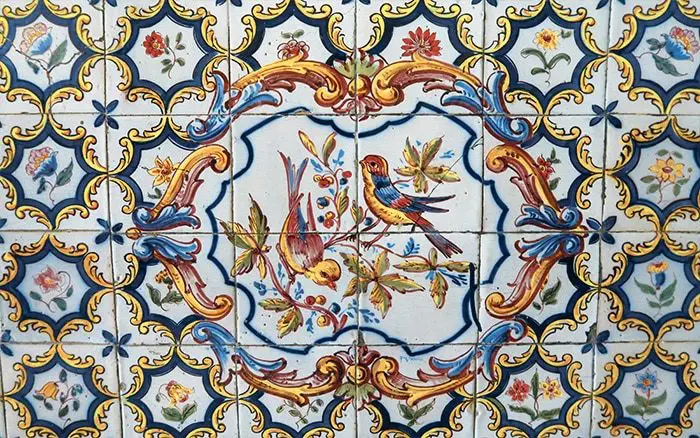
It’s also worth keeping in mind that Moroccan tiles in your home don’t have to be limited to a square shape. Depending on your home, hexagons could look better although they usually require more space.
Well, what about decorating furniture with Moroccan tiles? Could that work in a British home? Of course, it could! Especially when we’re talking about the bathroom. It’s safe to presume your bathroom is mostly going to be ceramic and usually white. That doesn’t mean it has to stay that way. Moroccan tiles are greatly used overseas as decor for sinks and basins as well as adding character to large shelves or storage cupboards. For example, a blue on white floral design could look great going in a circle inside a basin, with a more intricate and geometric style surrounding it. This way, you can use Moroccan tiles in a way that brightens up your bathroom without being overwhelming and awkward to look at.
Depending on the type of design you choose, Moroccan tiles can have a great impact on how big or small your space will appear afterwards.
Using bolder design with minimum and consistent colour (black, white and blue for example) can feel cosy yet doesn’t take away from the space and usually lightens up the bathroom. Darker and warmer designs, on the other hand, can be a little too restricting if not done correctly. Although at first, they may appear to make your bedroom look cosy, there’s the risk that with time it will simply look like it’s lacking space.
So why do people use Moroccan tiles as much as they do? And what are the reasons for their popularity not declining over the centuries?
One of the main answers lies in reputation. From the moment Moroccan Kitchen Tiles were brought over to the UK and all over the world, they have been the distinguishing design between the rich and the poor. Every country has classes and a hierarchy of wealth. One way apart from shiny cars and expensive suits, to show off your wealth is to decorate your home with Moroccan tiles that are definitely going to reflect the income. The fact Islamic tiles have mostly stayed hand painted is what puts the price and luxury tags on them, and the more you have the more it means you’ve spent your money on them.
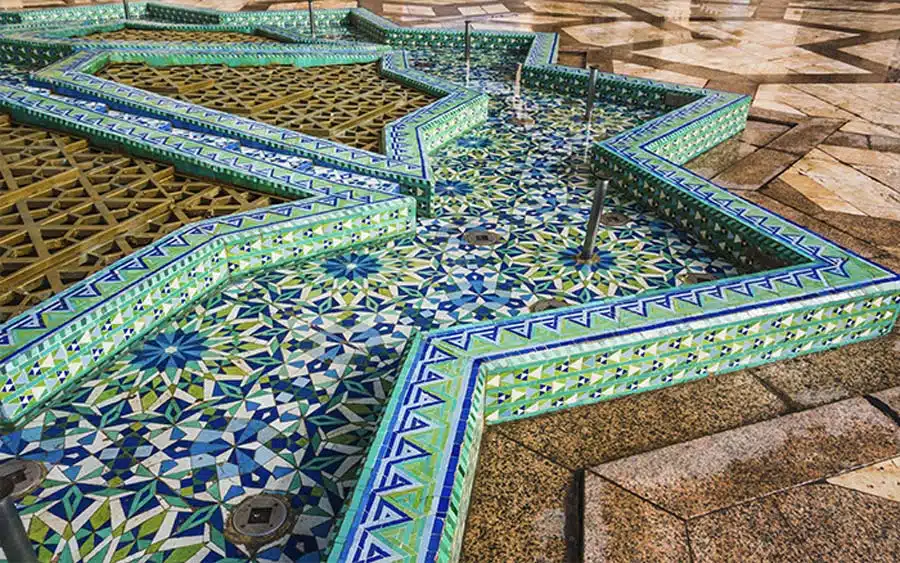
For many people also, Moroccan tiles are a way to bring a bit of holiday luxury home with them and have it constantly there. Moroccan tiles are greatly associated with relaxation as well as luxury.
This probably stems from their popularity in resorts and spas all over the world. For many homeowners, a place such as a bathroom is a place to relax and take away the stress of the day. What best way to create a space of peace than to imitate that of a luxurious resort in a hot country?
It’s a work of art that’s versatile. Versatility and personalisation are very important to many people and their homes. Unlike paintings that can only fit in certain places or survive certain conditions (there’s a reason we don’t hang paintings in bathrooms!), Moroccan tiles can go anywhere inside or outside the home and look equally good and classy. Each tile is a little work of art that pays tribute to the original artists of this type of pottery. There are thousands of designs and ideas out there to suit practically any home. If anything, it could make interior design a bit easier for the less creative homeowner.
There is a lot of choices. And by a lot, we mean tons of designs and textures to choose from. Moroccan tiles have the great ability to look good glazed and unglazed, and that usually cannot be said for other types of art on ceramic times. With Moroccan tiles, you can choose whether each tile is a story in itself or if one is just the puzzle piece to a larger beautiful image.
Moroccan tiles, especially now, have become a lot more affordable. Although hand painted is still mostly reserved for richer households, new technology has opened up the Moroccan tile marker to the general public. The beauty has been kept the same too. This means many more people can now get their hands on some Moroccan tile decor without actually overspending or holding back from designing their dream home.
The feel Moroccan tiles add to an ordinary British home is also a big deal. With many people getting in touch with their creative sides now more than ever, Moroccan tiles are a sign of art and culture and individuality. Incorporating art into everyday life is almost impossible with a nine to five office job in a suit so many people opt for making their homes large canvases of creativity and self expression.
Moroccan tiles look good in places that we never think to decorate.

However, some people find that a touch of Moroccan tiles to an unusual place such as that not only adds consistency to their decor but also quirkiness. Moroccan tiles can also look good above fireplace mantels without looking out of place. We can’t possibly imagine having plain white ceramic tiles above a fireplace, but throw in a Moroccan design and suddenly it starts looking really good. Moroccan tiles are mesmerising. Going back to the original geometric designs,
Moroccan tiles look good with any interior designs. When it comes to the rest of your interior design and the look you’re going for in your home, Moroccan tiles will always suit them. Plenty of us had to repaint a wall or rip out a fireplace for a new one or bin a painting because it no longer suits something else. That’s usually not a problem with Moroccan tiles as they simply blend in beautifully with anything you do. As they’re a work of art all by themselves, it’s easy for them to be always appreciated and look like a good centrepiece despite what else you might have going on.
If you would like to know more about Moroccan tiles and maybe need a hand choosing a design, contact us today. Our team of experts is more than happy to help you and give you some professional advice.
Unique Tiles Ltd is the world leading Custom Printed Tiles manufacturing company based in UK, Somerset. We offer the highest quality service in interiors trade, to help you create a truly unique look, within your very own home.
Copyright ©2011- 2024 Unique Tiles Ltd

